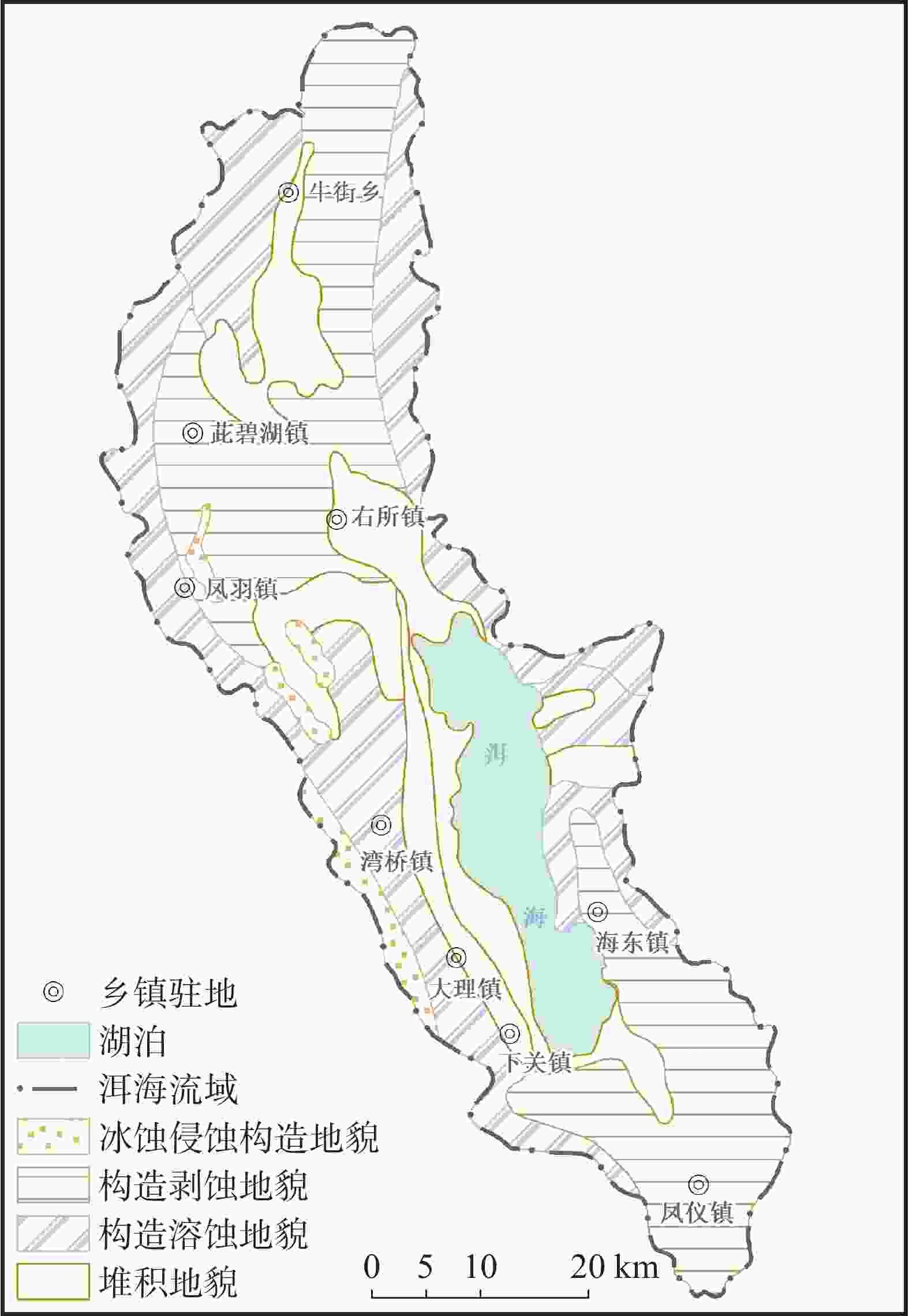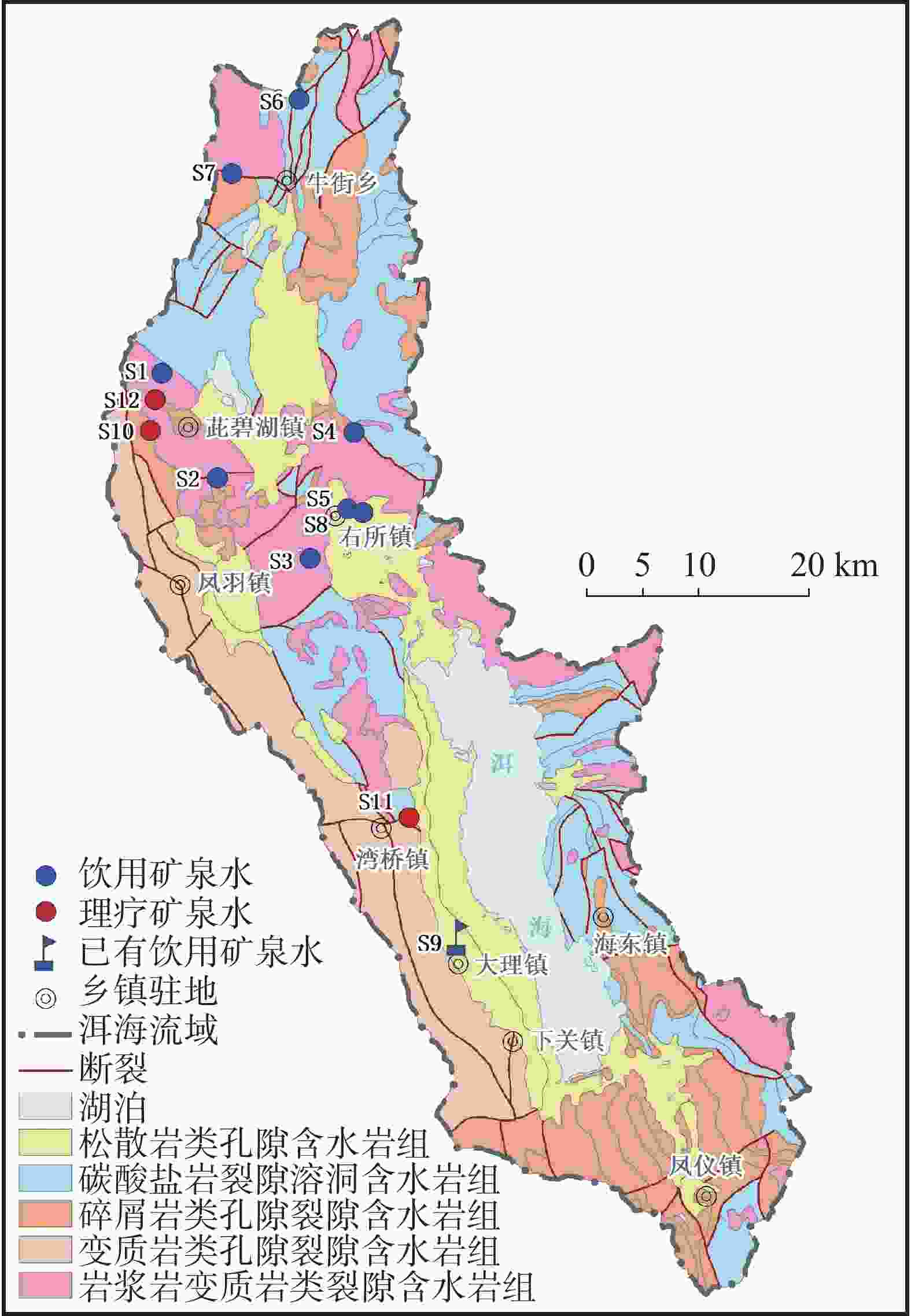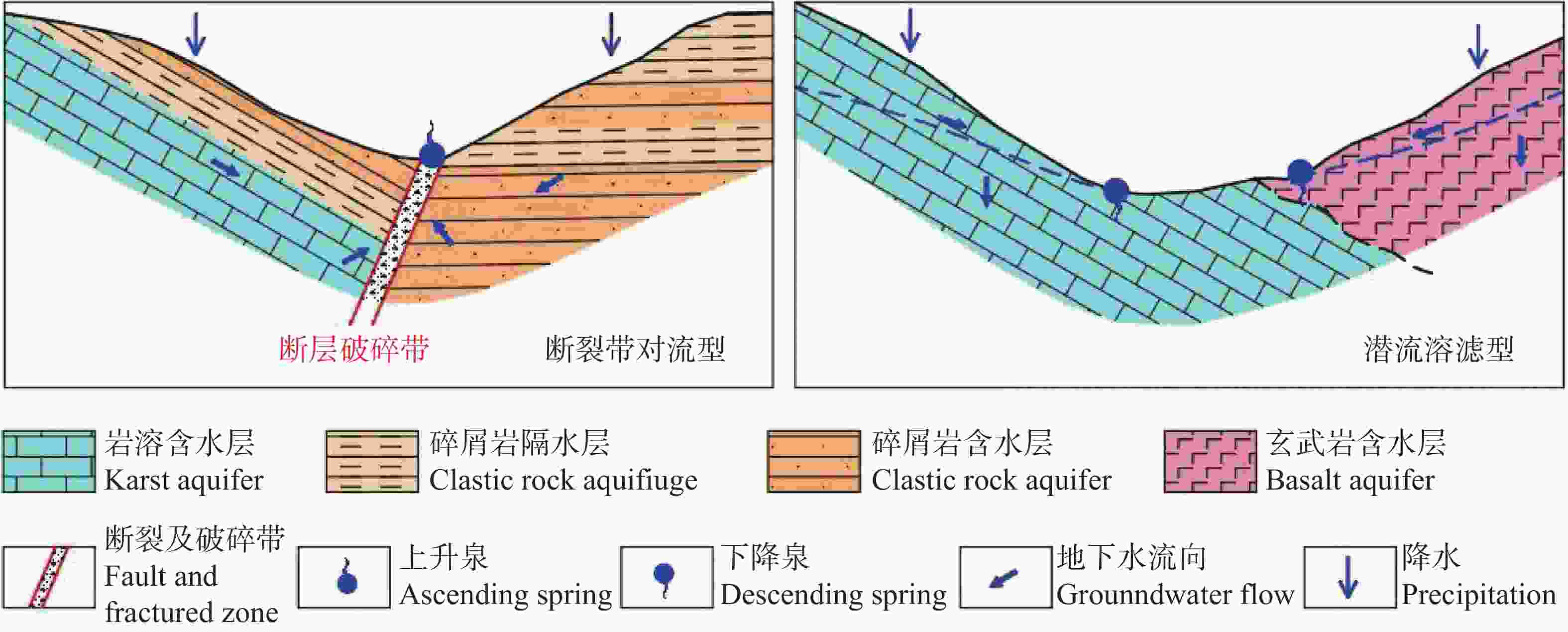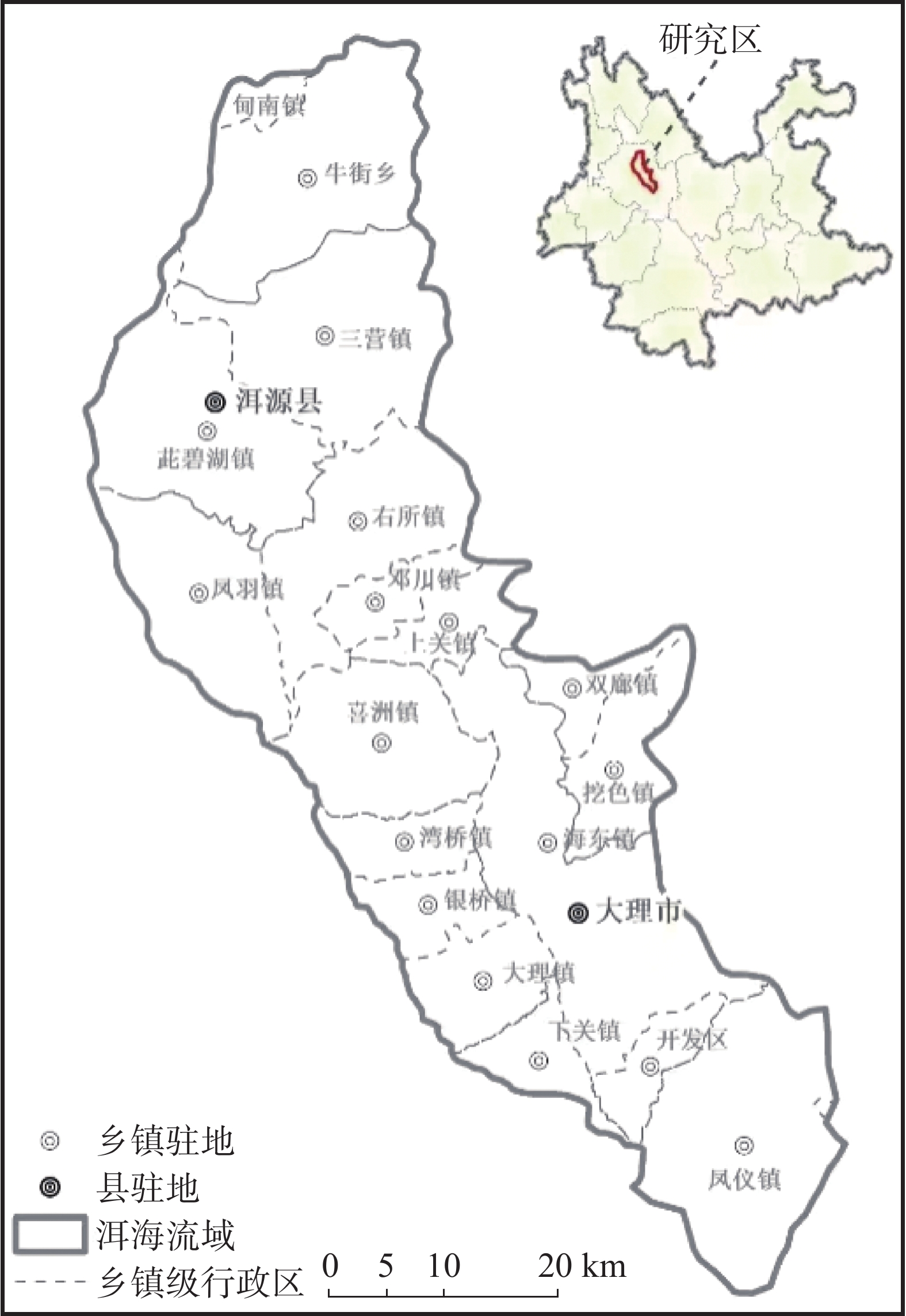Characteristics and prospective evaluation of natural mineral water resources in the Erhai lake basin
-
摘要: 为合理规划洱海流域矿泉水资源开发,避免过度开采,保障其可持续利用,需要深入研究洱海流域矿泉水资源特征及成因。文章依托地质调查项目,对矿泉水资源的水化学特征、分布情况及形成条件进行分析,通过系统归纳、类比分析、勘查实例举证等得知,流域矿泉水类型为偏硅酸饮用矿泉水、微量元素饮用矿泉水及理疗矿泉水,主要分布于流域西部断裂褶皱发育、地层岩性变化频繁及岩浆岩广布区域。矿泉水偏硅酸含量普遍较高,按形成条件主控因素可分为断裂带对流型和潜流溶滤型2种成因类型,前者多为优质理疗矿泉水,后者主要为偏硅酸饮用矿泉水。流域矿泉水资源丰富,现状开采利用率低,开采潜力大。文章对流域矿泉水资源特征进行分析并开展远景评价,科学制定保护和开发策略,研究成果可为维持流域生态平衡、维护生物多样性、促进区域经济与环境协调发展提供依据。Abstract:
The Erhai lake basin is an area with a beautiful ecological environment and important cultural and economic value in Southwestern China; therefore, in-depth studies on mineral water resources in this region hold far-reaching significance in ecology, environment, economy and society. This study is based on the project of the investigation of hydrogeological elements of typical wetland environment in the Erhai lake basin, located in northwest Yunnan. It systematically summarizes, organizes, and analyzes various factors, including landforms, stratigraphy and lithology, geological structure, climate, and water quality, based on extensive investigations and sampling tests. By examining the characteristics of mineral water resources, this study elucidates their water quality, quantity, and distribution patterns. Through a long-term evaluation, it forecasts the development potential and sustainable utilization prospects of these mineral water resources, thereby providing robust support for ecological protection, sustainable water resource utilization, economic development, and social stability in the Erhai lake basin. The mineral water resources in the basin encompass drinking mineral water containing both metasilicic acid and trace elements, and therapeutic mineral water. These resources are primarily distributed in a belt-like pattern across the western part of the basin, exhibiting higher abundance in the northwest and lower abundance in the southeast. They are more prevalent in mountainous areas and less so in the basin. These mineral water resources are typically located in regions with well-developed faults and folds, frequent variations in stratigraphic lithology, and a widespread presence of magmatic rocks. In terms of water quality characteristics, mineral water typically contains a high concentration of metasilicic acid. In areas with carbonate rocks, drinking mineral water often contains trace elements such as Sr and Zn. Conversely, in basalt regions, mineral water rich in metasilicic acid is more common. For therapeutic mineral water, both the concentration necessary for medical efficacy and the concentration required for classification as mineral water must meet or exceed three specific criteria. Based on the differences in the primary controlling factors of formation conditions—such as geological structure, topography, aquifer burial and distribution, and groundwater runoff circulation—the mineral water in the basin can be categorized into two types of genesis: fault-zone convection type and subsurface dissolution-filtration type. The fault-zone convection type constitutes 42% of the total and is characterized by deeper circulation, pressurization, higher water temperatures, and more stable dynamics. This type often yields high-quality therapeutic mineral water. In contrast, the subsurface dissolution-filtration type accounts for 58% and primarily produces drinking mineral water rich in metasilicic acid. This type is associated with simpler hydrogeological conditions, exhibiting characteristics such as shallower circulation depth, shorter cycles, and unstable dynamics. The Erhai lake basin is abundant in mineral water resources, which are currently underexploited, indicating significant potential for further development. Conducting research and analysis on the characteristics of these mineral water resources, performing long-term evaluations, and scientifically formulating protection and development strategies can help forecast the development potential and sustainable utilization prospects of mineral water resources. These efforts will contribute to the rational planning of the water resources development, help prevent over-exploitation, and ensure sustainable use. Furthermore, they will play a crucial role in maintaining the ecological balance of the basin, protecting biodiversity, and promoting the coordinated development of the regional economy and the environment. -
表 1 洱海流域饮用矿泉水水质特征
Table 1. Water quality characteristics of drinking mineral water in the Erhai lake basin
点号 位置 流量
/L∙s−1地下水
类型pH 溶解性总
固体/mg∙L−1达标项 微量元素指标 含量/mg∙L−1 S1 洱源县茈碧湖镇北排村北西300 m 24.76 岩溶下降泉 7.9 137.85 Zn 0.26 S2 洱源县茈碧湖镇大南村南东 1050 m17.50 裂隙下降泉 7.3 234.33 Sr 0.32 S3 洱源县右所镇甘家村南50 m 1.87 裂隙下降泉 7.2 119.54 H2SiO3 37.28 S4 洱源县右所镇赶羊涧村北800 m 12.10 岩溶上升泉 7.3 170.22 Sr 0.22 S5 洱源县右所镇太平村南西50 m 1.51 裂隙下降泉 7.2 165.12 H2SiO3 30.11 S6 洱源县牛街镇西村西北974 m 0.58 岩溶下降泉 8.0 381.54 Sr 0.21 S7 洱源县牛街镇天官坟村东南775 m 15.87 岩溶下降泉 7.9 155.05 Zn 0.25 S8 洱源县右所镇秦家营村南侧 1.20 裂隙上升泉 6.5 355.83 H2SiO3 33.25 S9 大理市大理古城西200 m 1.85 裂隙下降泉 7.5 73.47 H2SiO3 28.10 注:S9为流域内已开发“大理矿泉”品牌矿泉水。
Note: S9 is the brand mineral water of "Dali Mineral Spring" that has been developed in the basin.表 2 洱海流域医疗矿泉水水质特征
Table 2. Water quality characteristics of therapeutic mineral water in the Erhai lake basin
序号 位置 流量/L∙s−1 地下水类型 水温/℃ 达标指标 测试浓度 有医疗价值浓度 命名矿水浓度 矿水名称 mg∙L−1 S10 洱源县茈碧湖镇石
照壁村北西500 m15.20 裂隙上升泉 42 F 2.20 1 2 氟水、硅水、
温水H2SiO3 85.31 25 50 S11 大理市湾桥镇下崇
村南唐僧寺内7.20 裂隙上升泉 87 HBO2 3.89 1.2 50 氟水、硅水、
温水H2SiO3 192.38 25 50 F 9.00 1 2 Li 2.21 1 5 S12 洱源县茈碧湖镇伙
山村北东100 m4.02 裂隙上升泉 45 F 4.20 1 2 氟水、硅水、
温水H2SiO3 70.15 25 50 注:水温≥34 ℃达医疗价值浓度,且可命名为温水。
Note: When water temperature ≥34 ℃, it reaches therapeutic value concentration, and can be named warm water.表 3 洱海流域天然矿泉水点出露地层岩性
Table 3. Lithology of outcrops at natural mineral water points in the Erhai lake basin
点号 地层代号 出露岩性 
S1 D1q 中厚层—块状灰岩、石灰岩 S2 TE. 碱性玄武岩 S3 Pe 玄武岩 S4 T2b1 泥质灰岩夹粉砂岩、页岩 S5 Pe 玄武岩 S6 C3 灰岩,鲕状灰岩 S7 D1k 块状白云质灰岩、白云岩 S8 Pe 玄武岩 S9 Pt1C.2 片岩夹大理岩、结晶灰岩 S10 TE. 玄武岩 S11 Pt1C.2 大理岩、变质白云岩、结晶灰岩、片岩 S12 TE. 碱性玄武岩 表 4 洱海流域矿泉水资源开发利用现状
Table 4. Current situation of the development and utilization of mineral water resources in the Erhai lake basin
点号 位置 矿泉水
类型偶测流
量/m3∙d-1现状开采
量/m3∙d-1现状开发
利用状况利用
率/%S1 洱源县茈碧湖镇北排村北西300 m 饮用矿
泉水2139.26 1310.27 供下游村子约600人生活饮用 78 S2 洱源县茈碧湖镇大南村南东 1050 m1512.00 1512.21 泉口围砌成封闭水池,供附近村庄500~ 1000 人生活饮用及农田灌溉100 S3 洱源县右所镇甘家村南50 m 161.59 16.17 沿溪沟灌溉下游农田,大部分汇入西湖 10 S4 洱源县右所镇赶羊涧村北侧800 m 1045.44 940.92 泉口修砌成2个蓄水池,统一引水供3个村庄500~ 1000 生活饮用90 S5 洱源县右所镇太平村南西50 m 130.46 13.15 零星用于农田灌溉 10 S6 洱源县牛街镇西村西北974 m 50.11 0 自然流淌,汇入山沟 0 S7 洱源县牛街镇天官坟村东南775 m 1371.17 457.03 部分供下游村庄生产生活使用,剩余水量汇入水沟排至海西海水库 50 S8 洱源县右所镇秦家营村南侧 103.68 51.79 供附近少数村名生活饮用 50 S9 大理市大理古城区(已开发“大理矿泉”) 240.19 160.02 生产能力达到160 m3∙d−1 66 S10 洱源县茈碧湖镇石照壁村北西500 m 理疗矿
泉水1313.28 1313.28 主要供洗浴休闲,部分生活饮用 100 S11 大理市湾桥镇下崇村南唐僧寺内 622.08 62.20 少量用于农田灌溉,大量排入东侧洱海 10 S12 洱源县茈碧湖镇伙山村北东100 m 3523.39 3171.28 泉口建成蓄水池,引致下游
主要供洗浴休闲90 表 5 洱海流域矿泉水资源开采潜力
Table 5. Exploitation potential of mineral water resources in the Erhai lake basin
点号 位置 矿泉水类型 现状开采量
/万m3∙a1允许开采量
/万m3∙a1剩余允许开采
量/万m3∙a1S1 洱源县茈碧湖镇北排村北西300 m 饮用矿
泉水47.82 44.14 −3.68 S2 洱源县茈碧湖镇大南村南东 1050 m55.19 31.20 −23.99 S3 洱源县右所镇甘家村南50 m 0.59 8.13 7.54 S4 洱源县右所镇赶羊涧村北侧800 m 34.34 21.57 −12.77 S5 洱源县右所镇太平村南西50 m 0.48 5.75 5.27 S6 洱源县牛街镇西村西北974 m 0 1.79 1.79 S7 洱源县牛街镇天官坟村东南775 m 16.68 49.08 32.4 S8 洱源县右所镇秦家营村南侧 1.89 3.52 1.63 S9 大理市大理古城区(已开发“大理矿泉”) 5.84 8.76 2.92 S10 洱源县茈碧湖镇石照壁村北西500 m 理疗矿
泉水47.93 57.88 9.95 S11 大理市湾桥镇下崇村南唐僧寺内 2.27 12.84 10.57 S12 洱源县茈碧湖镇伙山村北东100 m 115.74 72.71 −43.03 -
[1] 宋德人. 我国饮用天然矿泉水的初步研究[J]. 地理科学, 1990, 10(4):356-364, 388.SONG Deren. A preliminary study on natural drinking mineral water of China[J]. Scientia Geographica Sinica, 1990, 10(4): 356-364, 388. [2] Monique van der Aa. Classification of mineral water types and comparison with drinking water standards[J]. Environmental Geology, 2003, 44(5): 554-563. [3] 苏春利, 李义连, 王焰新. 深圳市东湖矿泉水形成机理探讨[J]. 地质科技情报, 2003, 22(4):85-90.SU Chunli, LI Yilian, WANG Yanxin. Mechanism of form discussion of Donghu mineral water in Shenzhen City[J]. Geological Science and Technology Information, 2003, 22(4): 85-90. [4] 赵帅军, 黄树春, 夏友, 李海兵, 曾艳华. 从基础地质角度研究湖南省矿泉水资源特征及成因规律[J]. 矿产与地质, 2017, 31(1):187-193. doi: 10.3969/j.issn.1001-5663.2017.01.030ZHAO Shuaijun, HUANG Shuchun, XIA You, LI Haibing, ZENG Yanhua. Discussion of resource characteristics and genesis regularity of mineral water in respect to basic geology in Hunan Province[J]. Mineral Resources and Geology, 2017, 31(1): 187-193. doi: 10.3969/j.issn.1001-5663.2017.01.030 [5] 牛俊强, 文美霞, 郭昆, 周宁, 叶腾升, 苏呈. 湖北省饮用天然矿泉水成因类型及成矿模式分析[J]. 资源环境与工程, 2019, 33(1):61-65.NIU Junqiang, WEN Meixia, GUO Kun, ZHOU Ning, YE Tengsheng, SU Cheng. Analysis of genetic types and metallogenic model of potable natural mineral water in Hubei Province[J]. Resources Environment & Engineering, 2019, 33(1): 61-65. [6] 金文正. 云南省洱源县断裂特征及其对地热的控制作用[J]. 中国岩溶, 2024, 43(1):57-71.JIN Wenzheng. Characteristics of faults and their controlling effect on geothermal energy in Eryuan county, Yunnan Province[J]. Carsologica Sinica, 2024, 43(1): 57-71. [7] 单婷婷, 徐世光, 范柱国, 阮巍. 昆明西山偏硅酸矿泉水特征及形成机理[J]. 昆明理工大学学报(自然科学版), 2019, 44(2):39-47.SHAN Tingting, XU Shiguang, FAN Zhuguo, RUAN Wei. Characteristics and formation mechanism of metasilicate mineral water in Xishan mountain of Kunming[J]. Journal of Kunming University of Science and Technology (Natural Science), 2019, 44(2): 39-47. [8] 迟帅, 徐世光, 郭婷婷. 云南松茂区矿泉水成因研究[J]. 中国水运, 2019, 19(2):210-211. [9] 翟文秀, 伍尹犇, 伍早生. 云南省天然矿泉水资源开发利用现状及建议[J]. 云南地质, 2021, 40(4):473-478. doi: 10.3969/j.issn.1004-1885.2021.04.014ZHAI Wenxiu, WU Yinben, WU Zaosheng. The development and suggestion of natural spring water of Yunnan[J]. Yunnan Geology, 2021, 40(4): 473-478. doi: 10.3969/j.issn.1004-1885.2021.04.014 [10] 张贵, 张华, 王波, 张文鋆, 高瑜, 何绕生, 周翠琼, 彭淑惠. 滇东岩溶高原矿泉水类型及地质控制[J]. 地球学报, 2021, 42(3):333-340. doi: 10.3975/cagsb.2020.073101ZHANG Gui, ZHANG Hua, WANG Bo, ZHANG Wenjun, GAO Yu, HE Raosheng, ZHOU Cuiqiong, PENG Shuhui. Mineral water types and geological control in karst plateau of eastern Yunnan[J]. Acta Geoscientica Sinica, 2021, 42(3): 333-340. doi: 10.3975/cagsb.2020.073101 [11] 王楠, 胥芹, 孙小艳, 武显仓, 李常锁, 高帅 .趵突泉泉域岩溶水化学特征及成因研究[J]. 中国岩溶, 2024, 43(2):279-290.WANG Nan, XU Qin, SUN Xiaoyan, WU Xiancang, LI Changsuo, GAO Shuai. Hydrochemical characteristics and formation mechanism of karst water in Baotu Spring watershed[J]. Carsologica Sinica, 2024, 43(2): 279-290. [12] 周鑫, 王璨, 郑鹏飞, 姚腾飞, 巫政卿, 米茂生, 覃佐辉, 李杨. 湘南泥盆系碳酸盐岩区富锶饮用天然矿泉水成矿规律:以新田县新圩矿泉水为例[J]. 中国岩溶, 2022, 41(2):197-209.ZHOU Xin, WANG Can, ZHENG Pengfei, YAO Tengfei, WU Zhengqing, MI Maosheng, QIN Zuohui, LI Yang. Metallogenic regularity of strontium-rich drinking natural mineral water in Devonian carbonate area in southern Hunan: Taking strontium-rich drinking mineral water in Xinxu town, Xintian county as an example[J]. Carsologica Sinica, 2022, 41(2): 197-209. [13] 储昭升, 高思佳, 庞燕, 王圣瑞, 熊仲华, 段彪, 杨学松, 赵继东. 洱海流域山水林田湖草各要素特征、存在问题及生态保护修复措施[J]. 环境工程技术学报, 2019, 9(5):507-514. doi: 10.12153/j.issn.1674-991X.2019.07.291CHU Zhaosheng, GAO Sijia, PANG Yan, WANG Shengrui, XIONG Zhonghua, DUAN Biao, YANG Xuesong, ZHAO Jidong. Characteristics, problems and ecological protection and restoration measures of mountain-river-forest-farmland-lake-grassland elements in Lake Erhai basin[J]. Journal of Environmental Engineering Technology, 2019, 9(5): 507-514. doi: 10.12153/j.issn.1674-991X.2019.07.291 [14] 万晔, 韩添丁, 段昌群, 杨惠安. 滇西名山点苍山地区地貌结构与特征研究[J]. 冰川冻土, 2005, 27(2):241-248.WAN Ye, HAN Tianding, DUAN Changqun, YANG Huian. Landform system structures and characteristics of the Diancang mountain areas in west Yunnan Province[J]. Journal of Glaciology and Geocryology, 2005, 27(2): 241-248. [15] 林芸, 唐亚松, 刘刚, 刘胜. 洱海流域水资源量变化趋势分析[J]. 云南水力发电, 2017, 34(6):4-7.LIN Yun, TANG Yasong, LIU Gang, LIU Sheng. Analysis of the change trend of water resources in Erhai basin[J]. Yunnan Water Power, 2018, 34(6): 4-7. [16] 张春才, 郭加祥, 唐红明, 等. 云南省东部地区矿泉水调查报告[R]. 昆明:云南省地质矿产局第一水文地质工程地质大队, 1988. [17] 李继洪, 刘涛, 黄玉, 等. 云南省地热能开发利用规划(2014-2020年)[R]. 昆明:云南省地质环境监测院, 2014. [18] 沈照理. 水文地球化学基础[M]. 北京:地质出版社, 1986. [19] 周长松, 邹胜章, 朱丹尼, 林永生, 王佳, 樊连杰, 李军, 蓝芙宁, 李衍青, 邓日欣, 缪雄谊. 四川昭觉地区优质偏硅酸地下水的特征、成因及其开发利用建议[J]. 中国地质, 2022, 49(3):849-859.ZHOU Changsong, ZOU Shengzhang, ZHU Danni, LIN Yongsheng, WANG Jia, FAN Lianjie, LI Jun, LAN Funing, LI Yanqing, DENG Rixin, MIAO Xiongyi. Characteristics, causes and development suggestions of high quality groundwater containing metasilicate in Zhaojue area, Sichuan Province[J]. Geology in China, 2022, 49(3): 849-859. [20] 苏春田, 杨杨, 巴俊杰, 罗飞, 李小盼, 赵光帅. 新田县富锶地下水动态特点与成因分析[J]. 中国岩溶, 2020, 39(1):24-33. doi: 10.11932/karst2019y34SU Chuntian, YANG Yang, BA Junjie, LUO Fei, LI Xiaopan, ZHAO Guangshuai. Dynamic characteristics and genesis of strontium-rich groundwater in Xintian county, Hunan Province[J]. Carsologica Sinica, 2020, 39(1): 24-33. doi: 10.11932/karst2019y34 [21] 孙智杰, 高宗军, 王新峰, 林海斌, 宋绵. 赣南山区矿泉水出露模式探讨[J]. 地球学报, 2018, 39(5):565-572. doi: 10.3975/cagsb.2018.071001SUN Zhijie, GAO Zongjun, WANG Xinfeng, LIN Haibin, SONG Mian. Exploration of mineral water outcropping pattern in the mountainous area of south Jiangxi[J]. Acta Geoscientica Sinica, 2018, 39(5): 565-572. doi: 10.3975/cagsb.2018.071001 [22] 王志超, 王迪, 张兵华, 赵镇, 葛伟丽. 内蒙古饮用天然矿泉水地质成因和分布特征浅析[J]. 西部资源, 2023(5):17-24. doi: 10.3969/j.issn.1672-562X.2023.04.005 [23] 王宇. 红层地下水富集规律[J]. 地质灾害与环境保护, 2010, 21(2):53-57. doi: 10.3969/j.issn.1006-4362.2010.02.012WANG Yu. Groundwater enrichment in red beds[J]. Journal of Geological Hazards and Environment Preservation, 2010, 21(2): 53-57. doi: 10.3969/j.issn.1006-4362.2010.02.012 [24] 王波, 王宇, 张贵, 张华, 代旭升, 康晓波. 滇东南泸江流域岩溶地下水质量及污染影响因素研究[J]. 地球学报, 2021, 42(3):352-362. doi: 10.3975/cagsb.2020.070701WANG Bo, WANG Yu, ZHANG Gui, DAI Xusheng, KANG Xiaobo. A study of quality and pollution factors of karst groundwater in Lujiang river basin in southeast Yunnan[J]. Acta Geoscientica Sinica, 2021, 42(3): 352-362. doi: 10.3975/cagsb.2020.070701 [25] 王宇. 西南岩溶地区岩溶水系统分类、特征及勘查评价要点[J]. 中国岩溶, 2002,21(2):114-119. doi: 10.3969/j.issn.1001-4810.2002.02.008WANG Yu. classification, features of karst water system and key point for the evaluation to karst water exploration in Southwest China karst area[J]. Carsologica Sinica, 2002, 21(2): 114-119. doi: 10.3969/j.issn.1001-4810.2002.02.008 [26] 王波, 张华, 王宇, 张贵, 张文鋆, 高瑜, 罗为群. 泸西喀斯特断陷盆地地表水与地下水流域边界与水动力性质[J]. 中国岩溶, 2020, 39(3):319-326. doi: 10.11932/karst20200302WANG Bo, ZHANG Hua, WANG Yu, ZHANG Gui, ZHANG Wenjun, GAO Yu, LUO Weiqun. Watershed boundaries and hydrodynamic properties of surface water and groundwater in the Luxi karst fault-depression basin[J]. Carsologica Sinica, 2020, 39(3): 319-326. doi: 10.11932/karst20200302 [27] 王波, 郑礼永, 郭云, 等. 滇西北洱海流域典型湿地水文地质要素调查2019年度成果报告[R]. 昆明:云南省地质环境监测院, 2019. -




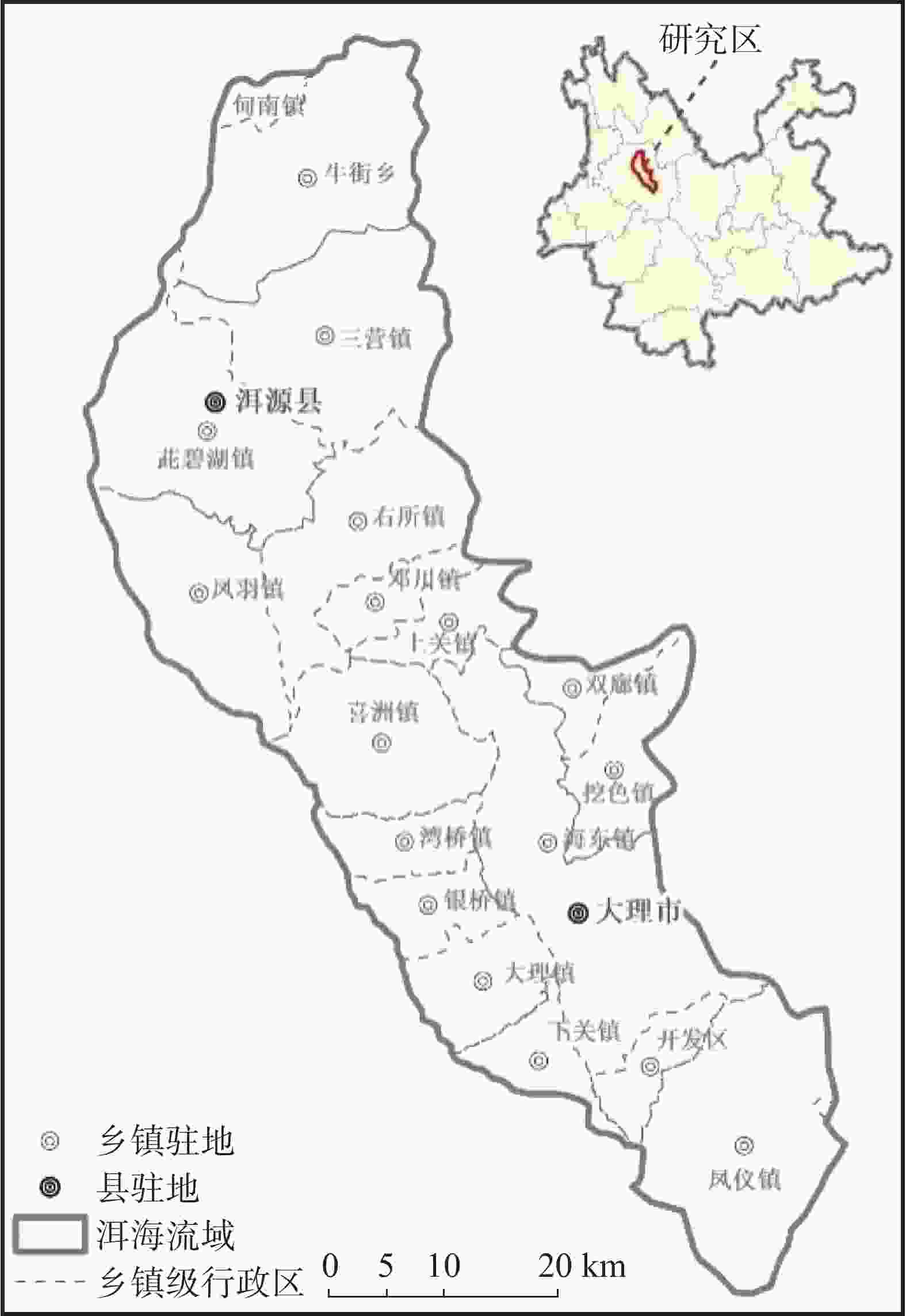
 下载:
下载:
